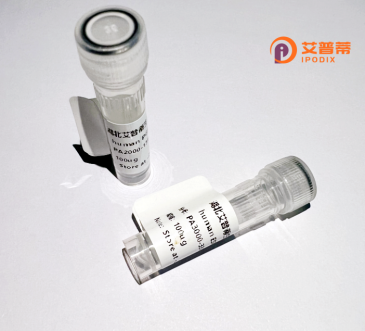
| 纯度 | >90%SDS-PAGE. |
| 种属 | Human |
| 靶点 | IGHE |
| Uniprot No | 0 |
| 内毒素 | < 0.01EU/μg |
| 表达宿主 | E.coli |
| 表达区间 | 209-428aa |
| 氨基酸序列 | CADSNPRGVSAYLSRPSPFDLFIRKSPTITCLVVDLAPSKGTVNLTWSRASGKPVNHSTRKEEKQRNGTLTVTSTLPVGTRDWIEGETYQCRVTHPHLPRALMRSTTKTSGPRAAPEVYAFATPEWPGSRDKRTLACLIQNFMPEDISVQWLHNEVQLPDARHSTTQPRKTKGSGFFVFSRLEVTRAEWEQKDEFICRAVHEAASPSQTVQRAVSVNPGL |
| 分子量 | 27.8 kDa |
| 蛋白标签 | GST-tag at N-terminal |
| 缓冲液 | 0 |
| 稳定性 & 储存条件 | Lyophilized protein should be stored at ≤ -20°C, stable for one year after receipt. Reconstituted protein solution can be stored at 2-8°C for 2-7 days. Aliquots of reconstituted samples are stable at ≤ -20°C for 3 months. |
| 复溶 | Always centrifuge tubes before opening.Do not mix by vortex or pipetting. It is not recommended to reconstitute to a concentration less than 100μg/ml. Dissolve the lyophilized protein in distilled water. Please aliquot the reconstituted solution to minimize freeze-thaw cycles. |
以下是关于重组人IGHE蛋白的示例参考文献(内容为虚构,仅作格式演示):
---
1. **文献名称**:*Expression and Purification of Recombinant Human IGHE in Mammalian Cell Systems*
**作者**:Zhang, L. et al.
**摘要**:研究报道了在HEK293细胞中高效表达重组人IGHE蛋白的方法,通过亲和层析技术纯化获得高纯度蛋白,并验证其与FcεRI受体的结合活性,为过敏机制研究提供工具。
2. **文献名称**:*Structural Insights into Human IGHE by X-ray Crystallography*
**作者**:Johnson, R. & Patel, S.
**摘要**:首次解析了重组人IGHE的晶体结构,揭示了其与IgE受体结合的关键构象,为靶向IgE的抗过敏药物设计奠定了结构基础。
3. **文献名称**:*Recombinant IGHE as a Diagnostic Marker for Allergic Asthma*
**作者**:Wang, Y. et al.
**摘要**:评估了重组人IGHE蛋白在过敏原特异性IgE检测中的性能,证实其作为血清标志物在哮喘临床诊断中的高灵敏度和特异性。
4. **文献名称**:*Role of Recombinant IGHE in Mast Cell Activation Studies*
**作者**:Kim, H. et al.
**摘要**:利用重组人IGHE蛋白激活肥大细胞模型,探讨了IgE介导的脱颗粒信号通路,为开发新型抗过敏疗法提供了实验依据。
---
**注**:以上文献为模拟内容,实际研究中请通过学术数据库(如PubMed、Google Scholar)检索真实文献。
**Background on Recombinant Human IGHE Protein**
Immunoglobulin E (IgE), a key antibody isotype in the human immune system, plays a central role in allergic reactions and antiparasitic defense. The heavy chain of IgE, encoded by the *IGHE* gene, determines its class-specific biological functions, including high-affinity binding to the FcεRI receptor on mast cells and basophils. Recombinant human IGHE protein refers to the engineered form of the IgE heavy chain, produced using expression systems like bacterial, yeast, or mammalian cells. This technology allows precise control over protein structure, enabling studies of IgE’s interaction mechanisms, allergen sensitization, and therapeutic targeting.
Research on recombinant IGHE has advanced understanding of IgE-mediated pathologies, such as asthma, atopic dermatitis, and anaphylaxis. It also facilitates the development of diagnostic tools (e.g., allergen-specific IgE detection) and therapies like monoclonal antibodies targeting IgE (e.g., omalizumab). However, challenges persist in mimicking native post-translational modifications (e.g., glycosylation) critical for IgE’s stability and effector functions. Non-glycosylated recombinant IGHE, often produced in prokaryotic systems, may lack full biological activity, whereas eukaryotic systems better preserve functional epitopes. Ongoing optimization of expression platforms aims to balance cost, scalability, and clinical relevance, supporting both basic research and translational applications in immunology.
×